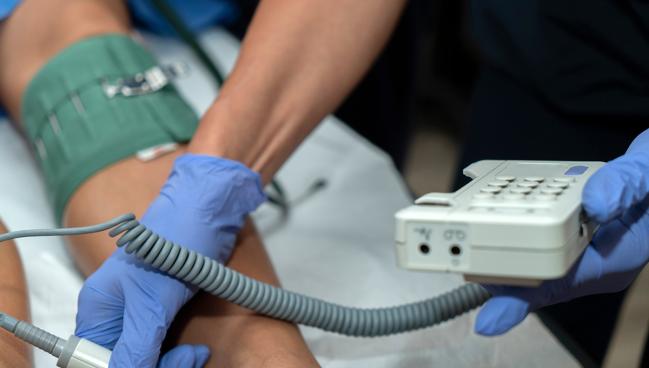REVIVE Injects Fresh Data Into Surgery vs Stenting Controversy for PAD
The study fills in some gaps left by BEST-CLI, but raises additional questions about medical therapy and choice, experts say.

Compared with surgery, PAD patients treated with bare-metal, covered, or drug-eluting stents have similar efficacy and safety outcomes at 2 years, the REVIVE pooled analysis shows.
Combining individual patient-level data from five RCTs, the study showed no differences between treatment groups for the primary endpoint of major adverse limb events (MALE), defined as the composite of all-cause death, major amputation, or target limb reintervention.
The REVIVE study, published January 23, 2023, in the Journal of the American College of Cardiology, was conducted prior to publication of the BEST-CLI trial, the largest head-to-head comparison of endovascular therapy and surgery in a chronic limb-threatening ischemia (CLTI) population. That long-awaited trial caused controversy with its conclusion that surgery results in fewer MALEs, major limb interventions, and amputations than endovascular therapy in patients with anatomy suitable to either surgery or endovascular interventions with balloons or stents.
Serdar Farhan, MD (Icahn School of Medicine at Mount Sinai, New York, NY), who led the REVIVE analysis, told TCTMD that REVIVE was intended as a bridge, of sorts, while new information was pending.
“Knowing that that the BEST-CLI trial was under conduction at the time, we thought that the COVID-19 pandemic might create a hitch for that trial, and we did not know whether it was going to be published on time,” said Farhan. For REVIVE, he and his colleagues contacted the primary investigators of all available RCTs investigating endovascular therapy with stent implantation versus bypass surgery with either a prosthetic or autologous vein graft to obtain the patient-level data.
The pooled analysis is reassuring, Farhan continued, especially for the general population of PAD patients who have intermittent claudication, which accounted for roughly 60% of both treatment groups. Prior meta-analyses, he noted, have not had the statistical power to shed light on MALE or amputation-free survival with endovascular therapy versus surgery.
We still have a lot more work to do, and I believe the future will be a combination of preventive medical approach plus revascularization. Serdar Farhan
Despite similar rates of MALE in the current analysis, the stented group had lower primary patency compared with the surgery group (adjusted HR 1.31; 95% CI: 1.02-1.69).
“However, when we take out all the patients who had technical failure, the difference in primary patency becomes nonsignificant,” he added. The rate of technical failure was 7.1% in the stent group versus none in the surgery group.
In an accompanying editorial, Marc Bonaca, MD, and Shea E. Hogan, MD (both CPC Clinical Research, Aurora, CO), say REVIVE helps fill in evidence gaps and sheds light on the high rates of MALE in these patients regardless of revascularization type.
“Even more concerning is that limb events represent the ‘tip of the iceberg’ for total ischemic events,” they write. Bonaca and Hogan add that the findings “show the unmet need for newer, more-effective medical therapies, including those that may have superior safety profiles.” That’s important, they note, given higher rates of bleeding in the surgical group compared with stenting (9.9% vs 4.9%; P = 0.01).
Factor XI inhibition may hold promise in some patients, particularly those with prosthetic grafts who develop thrombosis driven by the contact pathway, Bonaca and Hogan say.
Farhan agreed, telling TCTMD that REVIVE and BEST-CLI show the need “to look more granularly into medical management and at more preventive approaches for patients with intermittent claudication [to disrupt the pathway] where they are progressing from mild or moderate intermittent claudication towards severe or critical limb-threatening ischemia.”
Patency and Complications
Farhan and colleagues’ pooled analysis included a total of 639 patients (mean age 68 years; 29% women). All baseline characteristics were similar between the surgery (n = 314) and stenting (n = 325) groups except for baseline ankle-brachial index (ABI), which was higher in the endovascular group. Bare-metal stents were used in 31.7%, covered stents in 26.5%, and DES in 41.8%.
Primary patency was lower at 2 years in the endovascular cohort irrespective of age, sex, diabetes, clinical presentation, and lesion type or length, but there was no difference in MALE (40.1% vs 36.4%; log-rank P = 0.447). Secondary endpoints of amputation-free survival, all-cause death, major amputation, and reintervention of the target limb were also no different between groups.
Compared with the surgery group, those who received stents had fewer early complications (6.8% vs 22.6%) and shorter hospital stays (3.1 ± 4.2 days vs 7.4 ± 4.9 days; P < 0.001 for both). The composite of any bleeding, infection, or all-cause death within 30 days was 6.8% in the stented group and 22.6% in the surgery group (P < 0.001). This difference was driven by all-cause bleeding and infection.
The surgical group saw higher postprocedural ABI and greater improvement in ABI between baseline and postprocedure. At 6, 12, and 24 months, both treatment groups had similar Rutherford class, but early improvement (between baseline and 6 months) was lower in the endovascular group.
“We still have a lot more work to do, and I believe the future will be a combination of preventive medical approach plus revascularization,” Farhan said. “It appears that BEST-CLI is going to have some forthcoming subanalyses that are going to shed even more light into which patient populations will benefit more from bypass surgery as compared to endovascular.”
REVIVE, BEST-CLI, and Beyond
Commenting for TCTMD, Eric A. Secemsky, MD (Beth Israel Deaconess Medical Center, Boston, MA), said despite some obvious differences between REVIVE and BEST-CLI, the new analysis provides needed data to continue the conversation about best strategy. It also provides data on technical failure rates that he said are close to what many endovascular specialists believe they should have seen in the BEST-CLI experience.
REVIVE also may provide a clue about how the greater incidence of early complications like bleeding and infections with surgery impacts patients over time compared with an endovascular approach, he added.
“It makes you wonder if the penalty of paying for things up front has a toll, even if the long-term benefits were in favor of surgery,” Secemsky said.
What I hope we will see . . . is all of us opening our communication more, working together, putting the patient first, and tailoring treatment recommendations to each individual. Eric A. Secemsky
When BEST-CLI was presented in November at the American Heart Association 2022 Scientific Sessions, it was followed by a prespecified quality-of-life (QoL) subanalysis that surprisingly showed no differences at 1 year between surgery and endovascular treatment on any health-related QoL measure, but did give an edge to endovascular therapy on several patient-reported instruments.
Bonaca and Hogan say the REVIVE analysis also supports the idea of multidisciplinary PAD teams “akin to critical limb ischemia and heart teams” and shared decision-making with patients regarding disease-management options.
For Secemsky, the combination of BEST-CLI, REVIVE, and the forthcoming BASIL-2 study adds up to more data in this space than has been seen in decades.
“It’s going to allow us to fully contextualize the complementary roles for both of these revascularization options for our lower limb patients,” he said. “What I hope we will see as a result of this study, BEST-CLI, and what's to come, is all of us opening our communication more, working together, putting the patient first, and tailoring treatment recommendations to each individual.”
L.A. McKeown is a Senior Medical Journalist for TCTMD, the Section Editor of CV Team Forum, and Senior Medical…
Read Full BioSources
Farhan S, Enzmann FK, Bjorkman P, et al. Revascularization strategies for patients with femoropopliteal peripheral artery disease. J Am Coll Cardiol. 2023;81:358-370.
Bonaca MP, Hogan SE. Tradeoffs in approach to PAD revascularization: shared decision making in the spotlight. J Am Coll Cardiol. 2023;81:371-373.
Disclosures
- Farhan and Hogan report no relevant conflicts of interest.
- Bonaca reports modest stock holdings in Medtronic and Pfizer; and has received consulting fees from Audentes.
- Secemsky reports grants to his institution from BD, Boston Scientific, Cook, CSI, Laminate Medical, Medtronic, and Philips; and speaking/consulting fees from Abbott, BD, Bayer, Boston Scientific, Cook, CSI, Inari, Janssen, Medtronic, Shockwave, and Philips.





Comments